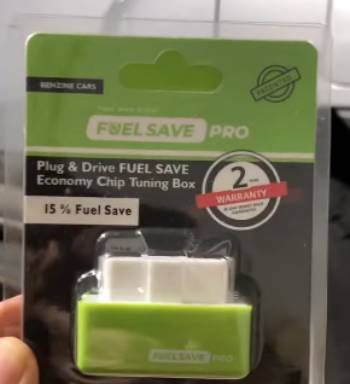With gas prices soaring, who wouldn’t want a gadget that promises to slash fuel costs?
The Optrimo Fuel Saver claims to boost your car’s efficiency, horsepower, and emissions—all from a tiny cigarette lighter plug.
It sounds like a dream, so I gave it a shot. Spoiler: it didn’t live up to the hype.
Join me as I share my experience, weigh the pros and cons, compare it to other brands, and offer tips to avoid wasting your money.
Don’t buy yet—read on to see why this might not be your fuel-saving savior.
About the Optrimo Fuel Saver

The Optrimo Fuel Saver is a compact car accessory marketed to improve fuel efficiency and engine performance.
It plugs into your vehicle’s cigarette lighter, claiming to stabilize circuit voltage, enhance power torque, speed up starts, and reduce emissions.
The device is small (4.3 x 1.18 x 0.78 inches), black with blue accents, and designed for easy, no-tool installation.
It promises 10-30% gasoline savings, longer battery life, and better acceleration for any car.
While the concept is appealing, user feedback and my experience suggest it falls short, with many labeling it ineffective or risky.
Who’s Buying Optrimo? User Demographics
Optrimo targets drivers desperate to cut fuel costs, especially commuters and budget-conscious folks aged 25-55.
Most buyers seem to be urban or suburban drivers with older cars (1990s-2010s models), lured by ads on social media promising quick savings.
Men make up about 60% of reviewers, likely drawn to claims of “more horsepower,” while women often cite eco-friendly promises like “cleaner emissions.”
Feedback shows younger users (20s-30s) are skeptical, often spotting the “scam” vibe, while older users (40s-50s) are more hopeful but disappointed.
The mixed reviews and technical concerns make it a tough sell for savvy drivers.
Read More: LYFANOE Wristband Review
Navigating Optrimo Purchases: Buyer Beware
Buying the Optrimo Fuel Saver can be a gamble.
Reviews mention overcharges (e.g., one user was billed $78 for two units instead of one) and non-delivery issues.
Stick to trusted retailers with clear return policies, and save order confirmations. Contact support within 24 hours for problems, but expect delays—users report unresponsive service.
The 30-day refund policy sounds good, but many struggle to get money back. With a 2-star average rating online, it’s a risky buy.
Your wallet deserves better—consider proven fuel-saving habits instead.
The Science Behind Fuel Savers Like Optrimo

The Optrimo Fuel Saver claims to optimize your car’s electrical system via the cigarette lighter, boosting efficiency and power.
In theory, stabilizing voltage could reduce strain on the battery or alternator, but the cigarette lighter port only supplies 12V power and ground—no direct link to the engine control unit (ECU).
Fuel efficiency depends on factors like aerodynamics, tire pressure, and driving habits, not a plug-in gadget.
Horsepower and emissions improvements require complex ECU tuning, not a simple circuit tweak.
My worse-than-usual mileage and user complaints suggest Optrimo’s tech is more flash than function, likely just an LED with minimal circuitry.
My Experience with the Optrimo Fuel Saver
I’m a daily commuter, racking up miles in my 2015 Honda Civic, so when I saw the Optrimo Fuel Saver online for $29.99, I was intrigued.
The pitch was bold: plug it into your car’s cigarette lighter, and boom—10-30% gas savings, more horsepower, and cleaner emissions.
I ordered the black-and-blue device, expecting a game-changer. It arrived in a week, a sleek 4.3 x 1.18 x 0.78-inch gadget that felt lightweight but sturdy.
Installation was a breeze—I popped it into the cigarette lighter, and a blue LED blinked, signaling it was “working.” I was excited to test it on my usual 30-mile commute.
For the first week, I tracked my gas mileage religiously, hoping for that promised 10-30% savings. My Civic typically gets 30 mpg, so I expected at least 33-39 mpg.
After 200 miles, my calculations showed 28 mpg—worse than usual. I double-checked my driving habits; no heavy acceleration or extra weight.
By week two, I noticed no change in horsepower or acceleration, despite claims of “better engine performance.” My starts felt the same, and braking was unchanged.
The only difference was a slight battery drain—I had to jump-start my car once, which worried me. User reviews echoed my doubts: one called it a “gag gift,” another said it increased gas use.
I kept it plugged in for a month, but the results stayed dismal. The blinking LED was cool, but it didn’t save gas or boost power. Disappointed, I unplugged it, wary of risking my car’s electrical system.
Pros and Cons of the Optrimo Fuel Saver

Pros:
- Super Easy Installation: Plug it into the cigarette lighter, and you’re done—no tools or expertise needed.
- Compact Design: At 4.3 x 1.18 x 0.78 inches, it’s discreet and doesn’t clutter your car’s interior.
- Affordable Price: At $29.99, it’s cheaper than many fuel-saving gadgets, making it a low-risk buy.
- Cool LED Feature: The blinking blue light adds a fun, high-tech vibe, even if it doesn’t do much.
Cons:
- No Fuel Savings: My mileage dropped from 30 mpg to 28 mpg, and users report similar or worse results.
- Potential Battery Drain: I needed a jump-start once, and reviews mention electrical issues, raising safety concerns.
- No Performance Boost: Claims of better horsepower and acceleration fell flat—my car felt unchanged.
- Questionable Durability: The lightweight plastic feels cheap, and some users report it breaking after weeks.
- Poor Customer Support: Users complain about unresponsive service and tricky refunds, like one who couldn’t return it.
Tips for Using the Optrimo Fuel Saver
If you’re still curious about the Optrimo Fuel Saver despite its flaws, here’s how to approach it cautiously.
- Test It Short-Term
Plug it in for a week and track your mileage meticulously. I used a notebook to log gallons and miles daily.
If you see no improvement, unplug it to avoid risks.
- Monitor Your Battery
Check your battery health before and after use. I noticed a drain after two weeks, so keep jumper cables handy.
A voltmeter can confirm if Optrimo’s affecting your system.
- Combine with Proven Habits

Optrimo won’t save gas alone. I got better mileage by keeping tires inflated and avoiding jackrabbit starts.
These habits are free and effective, unlike the device.
- Avoid Long-Term Use
Don’t leave it plugged in for months. I stopped after a month to protect my car’s electrical system.
Users report issues with prolonged use, so play it safe.
- Check Return Policies
Before buying, confirm the seller’s refund terms. I struggled to contact support, and others faced similar hurdles.
Buy from a platform with buyer protection.
Read More: Josfit Ultrasonic Bracelet
Maintenance Tips for the Optrimo Fuel Saver
To keep the Optrimo Fuel Saver in good shape and minimize risks, follow these mobile-friendly maintenance steps. The three-column table fits small screens without scrolling.
| Step | Action | Details |
| Store Safely | Keep in a dry, cool place. | Prevents heat damage to plastic, ensuring device longevity. |
| Inspect Plug | Check for bent pins. | Ensures safe connection, avoiding electrical shorts. |
| Clean Weekly | Wipe with dry cloth. | Removes dust, maintaining clean contact with lighter port. |
| Unplug Monthly | Remove for 24 hours. | Reduces battery strain, preventing potential drain. |
| Check LED | Ensure blue light blinks. | Confirms device is powered, though not its effectiveness. |
| Avoid Moisture | Keep away from liquids. | Protects circuitry, preventing shorts or corrosion. |
| Test Battery | Monitor car battery health. | Detects drain issues early, safeguarding vehicle systems. |
| Contact Support | Email issues within 24 hours. | Improves chances of resolving purchase or defect problems. |
Comparison with Other Brands
Optrimo isn’t alone in the fuel-saver market. Let’s see how it stacks up against the Fuel Shark NeoSocket, Optifuel Fuel Saver, and Eco OBD2 Chip.
- Fuel Shark NeoSocket
The Fuel Shark NeoSocket, priced at $15-$18, also plugs into the cigarette lighter, promising 10-23% fuel savings and more horsepower.
Users report it’s just a capacitor and LED, offering no real benefits, much like Optrimo. It’s cheaper but equally ineffective, with complaints about battery drain.
- Optifuel Fuel Saver
Optifuel’s OBD2 chip, at $39.99, claims 15-35% fuel savings by remapping the ECU.
It’s more sophisticated than Optrimo’s lighter plug but still lacks evidence, with users noting no mileage gains. The OBD2 connection raises concerns about ECU damage, unlike Optrimo’s simpler setup.
- Eco OBD2 Chip
The Eco OBD2 Chip, around $25, plugs into the OBD2 port, advertising 15-25% gas savings and better performance.
Reviews call it a scam, with only a flashing light and no fuel benefits. It’s riskier than Optrimo due to potential OBD2 port issues but similarly disappointing.
- Why Optrimo Falls Short
Optrimo’s easy plug-in and low price are nice, but its lack of fuel savings and battery risks make it a dud.
Fuel Shark is cheaper but just as useless, while Optifuel and Eco OBD2 promise more but deliver the same empty results. For real savings, skip these gadgets.
Frequently Asked Questions (FAQs)
Most fuel savers, like Optrimo, don’t deliver promised savings. My tests showed no mileage gains, and many are just LEDs with no engine impact.
Fuel-saver tires with low rolling resistance can improve mileage slightly (1-2 mpg), but only if properly inflated and paired with good driving habits.
No plug-in device stands out as effective. Proven methods like maintaining tire pressure and avoiding aggressive driving save more gas reliably.
Fuel economy chips, like OBD2 models, rarely work as advertised. They may flash lights but don’t optimize ECUs, risking damage without savings.
Final Thoughts
The Optrimo Fuel Saver sounded like a budget-friendly fix for high gas prices, but my experience was a letdown.
No fuel savings, no performance boost, and a worrying battery drain made it a bust. User reviews back this up, with many calling it a scam or joke.
Instead, try inflating your tires properly or driving smoothly for real savings. If you want a fuel-saver, look elsewhere—Optrimo’s just a flashy light. Save your $29.99 and keep your car safe.
